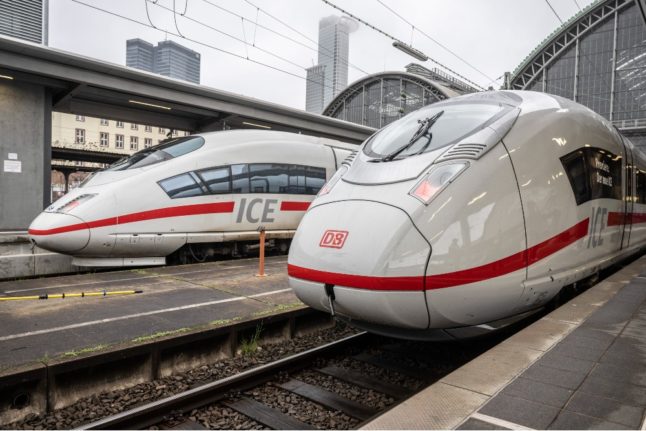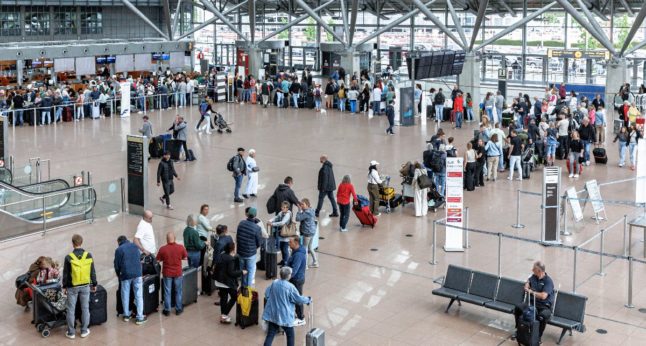Germany’s state-owned train company Deutsche Bahn is notorious for its delays and breakdowns – with complaining about them practically a pastime among many Germans.
It didn’t help when DB head Richard Lutz presented a report on Monday about the Bahn’s June performance: only 63.5 percent of all Deutsche Bahn long-distance ICEs and ICs arrived with delays of less than six minutes.
DB did not count cancelled long-distance trains, or weekly reports of broken-down trains on tracks which had to be evacuated. They included a Leipzig-bound train in late June, when all 800 passengers had to get off board when the air conditioner broke down.
READ ALSO: How to get compensation for delayed or cancelled trains in Germany
Meet the new Neo
But to improve punctuality – and their reputation – Deutsche Bahn is casting its hopes on the long-distance ICE 3Neo, which can run at a top speed of 320 kilometres per hour.
“If the train doesn’t come on time,” DB board member Michael Peterson announced Monday of the completely redesigned ICE 3neo, “it’s not because of this train.”
READ ALSO: ICE 3neo: Deutsche Bahn’s speediest train makes first trip in Germany
Following the success of the first ten 3neo trains put on Germany tracks since December 2022, Deutsche Bahn is now ordering an additional 90 trains from manufacture Siemens at a cost of €3 billion.
A total of 30 ICE 3neo trains alone are to run within Germany as early as the end of 2023.
Why have there been so many DB delays?
DB cites the numerous construction sites and the dilapidated track infrastructure as the main reasons for train delays – of which it’s been experiencing a record number in 2023. But staff shortages and technical bre wiakdowns onboard – especially with the air conditioning in the summer months – are also bringing services to a standstill in some cases.
“Things are going much better with the ICE 3neo,” Karl-Peter Naumann from the passenger association Pro Bahn told the Handelsblatt business daily.

Peterson was also pleased with the new trains. “The new model has the lowest susceptibility to faults in our fleet,” he said, pointing out that the ICE 3neo is so far free of “teething problems”.
That sets it apart from its predecessors. In particular, the ICE 2, in service since 1994, had caused a series of breakdowns that led to failures time and again. In addition, the ICE 1, which was launched in 1987, is still in use and has long since become outdated, despite renovations, according to industry experts.
“Our long-distance fleet has an average age of 18 years,” said Peterson, an amount of time DB hopes to bring down to 12.
Its predecessor ICE 4, which can run up to 265 kilometres per hour, will continue to be put into service alongside the ICE 3neo. Right now it most commonly runs along a new Berlin to Munich route.
DB expects to have 530 of the streamlined express trains in operation by 2030, up from just 385 today.
READ ALSO: Why Swiss transport authorities want to ban German trains
What does the new 3neo look and feel like?
In addition to increased reliability, the manufacturer Siemens Mobility has promised DB passengers more comfort in the ICE 3neo.
The carriages are equipped with a “redundant air-conditioning system” that takes over when the first cooling system gives up in the summer heat.
Such a device already exists in the ICE 4, but now Siemens says it’s upped the performance.
In addition, mobile phone reception in the train is set to be significantly improved. Siemens has milled an almost invisible grid into the metal coating of the windows to make it easier for radio waves to penetrate the interior. Improvements are also planned for the predecessor ICE 4.
The train’s interior has also been completely redesigned: the seats have been given a softer colour with dark blue and grey and new fabrics. The carpets are new, as is the wood panelling on the back of the seats in first class.
Instead of chrome, the ICE 3neo now uses brushed aluminium. The passenger association Pro Bahn has also praised the installation of two additional wheelchair doors, and the increased space for bicycles.
From the second half of 2024, the first ICE 3neo trains are also expected to be rolled out internationally on routes heading to neighbouring Belgium and the Netherlands.



 Please whitelist us to continue reading.
Please whitelist us to continue reading.
Member comments